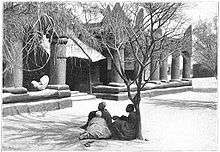Sultanate of Damagaram



The Sultanate of Damagaram was a powerful pre-colonial state in what is now southeastern Niger, centered on the city of Zinder.
History
Rise
The Sultanate of Damagaram was founded in 1731 (near Myrria, modern Niger) by Muslim Kanouri aristocrats, led by Mallam (r. 1736–1743). Damagaram was technically a vassal state of the decaying Kanem-Bornu Empire, but quickly came to conquer all its fellow vassal states of western Bornu. In the 1830s, the small band of Bornu nobles and retainers conquered the Myrria kingdom, the Sassebaki sultanates (including Zinder). By the 19th century, Damagaram had absorbed 18 Bornu vassal states in the area.
Zinder rose from a small Hausa village to an important center of the Trans-Saharan trade with the moving of the capital of Damagaram there in 1736. The large fortress of the southeast central city (Birini) was built shortly thereafter, and became a major hub for trade south through Kano and east to Bornu. The Hausa town and Zengou, its Tuareg suburb,[1] expanded with this trade.
Apex
Damagaram had a mixed relationship with the other major regional power, the Sokoto Caliphate to the south. While it provided aid to the animist Hausa led refugee states to its west (in what is now Niger) who were formed from the rump of the states conquered by the Sokoto Caliph, Damagaram also maintained good relations with its southern neighbors. Damagaram sat astride the major trade route linking Tripoli to Kano, one of the more powerful Sokoto sultanates, which provided the economic lifeblood of both states. An east west trade from the Niger River to Bornu also passed through Zinder, making relations with animist neighbors like Maradi or the Gobirwa as profitable, and thus important. Damagaram also covered some of the more productive of Bornu's western salt producing evaporation mines, as well as farms producing Ostrich feathers, highly valued in Europe.
In the mid 19th century, European travelers estimated the state covered some 70,000 square kilometers and had a population over 400,000, mostly Hausa, but also Tuareg, Fula, Kanuri, Arab and Toubou. At the center of the state was the royal family, a Sultan (in Hausa the Sarkin Damagaram) with many wives (an estimated 300 wives by visitor Heinrich Barth in 1851) and children, and a tradition of direct (to son or brother) succession which reached 26 rulers by 1906. The sultan ruled through the activities of two primary officers the: Ciroma (Military commander and prime minister) his heir-apparent the Yakudima. By the end of the 19th century, Damagaram could field an army of 5,000 cavalry, 30,000 foot soldiers, and a dozen cannons, which they produced in Zinder. Damagaram could also call upon forces of the allied Kel Gres Tuareg who formed communities near Zinder and other parts of the sultanate.
French conquest
When the French arrived in force in the 1890s, Zinder was the only city of over 10,000 in what is today Niger. Damagaram found itself threatened by well-armed European incursions to the west, and the conquering forces of Rabah to the east and south. In 1898, A French force under Captain Marius Gabriel Cazemajou spent three weeks under the Sultan's protection in Damagaram. Cazemajou had been dispatched to form an alliance against the British with Rabah, and the Sultan's court were alarmed at the prospect of their two most powerful new threats linking up. Cazemajou was murdered by a faction at the court, and the remainder of the French escaped, protected by other factions. In 1899, the reconstituted elements of the ill fated Voulet-Chanoine Mission finally arrived in Damagaram on its way to revenge Cazemajou's death. Meeting on 30 July at the Battle of Tirmini, 10 km from Zinder, the well-armed Senegalese-French troops defeated the Sultan and took Damagaram's capital.
With colonialism came the loss of some of Damagaram's traditional lands and its most important trade partner to the British in Nigeria.
The French placed the capital of the new Niger Military Territory there in 1911. In 1926, following fears of Hausa revolts and improving relations with the Djerma of the west, the capital was transferred back to the village of Niamey.
The brother of Sultan Ahmadou mai Roumji had earlier sided with the French, and was placed on the throne in 1899 as Sultan Ahamadou dan Bassa. Following French intelligence that a rising by Hausa in the area were preparing a revolt with the aid of the Sultan, a puppet Sultan was placed in power in 1906, though the royal line was restored in 1923. The Sultanate continues to operate in a ceremonial function into the 21st century.
Sultans of Damagaram
- Mallam 1731–46
- Baba dan Mallam 1746–57
- Tanimoun Babani 1757–75
- Assafa dan Tanimoun 1775–82
- Abaza dan Tanimoun 1782–87
- Mallam Babou Saba 1787–90
- Daouda dan Tanimoun 1790–99
- Ahmadou dan Tanimoun 1799–1812
- Sulayman 1812–22
- Ibrahim 1843–51
See also
References
- Columbia Encyclopedia:Zinder
- ZINDER, Encyclopædia Britannica (1911)
- James Decalo. Historical Dictionary of Niger. Scarecrow Press/ Metuchen. NJ - London (1979) ISBN 0-8108-1229-0
- Finn Fuglestad. A History of Niger: 1850–1960. Cambridge University Press (1983) ISBN 0-521-25268-7